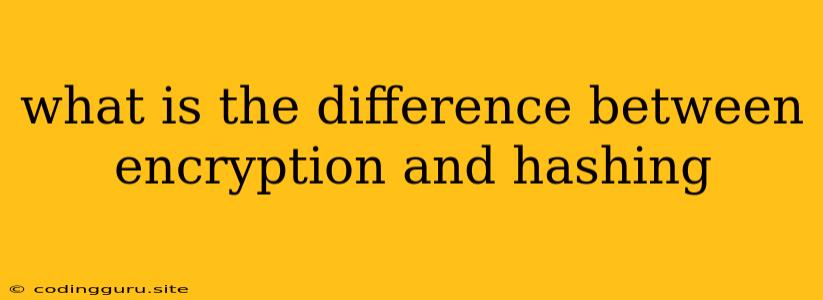What is the Difference Between Encryption and Hashing?
In the realm of cybersecurity, encryption and hashing are essential techniques that play crucial roles in safeguarding sensitive data. While both processes involve transforming data into an unreadable format, they serve distinct purposes and employ different methods. Understanding the fundamental differences between encryption and hashing is crucial for comprehending the security landscape and making informed decisions about data protection strategies.
Encryption: Protecting Data Confidentiality
Encryption is a process that converts plaintext (readable data) into ciphertext (unreadable data) using an algorithm and a key. This transformation renders the data unintelligible to unauthorized individuals. The key is a secret piece of information that unlocks the encryption process, allowing the original plaintext to be recovered.
Encryption is primarily used to protect data confidentiality, ensuring that only authorized individuals can access and understand sensitive information. Imagine a locked box where only the person with the key can open it and reveal the contents. This analogy illustrates the core functionality of encryption, where the key serves as the gateway to accessing the encrypted data.
Here are some key characteristics of encryption:
- Reversibility: Encrypted data can be decrypted back into its original form using the corresponding key.
- Key Management: Securely storing and managing encryption keys is crucial, as compromised keys can compromise the security of encrypted data.
- Types of Encryption: Various encryption algorithms exist, each with its own strengths and weaknesses. Common examples include AES (Advanced Encryption Standard) and RSA (Rivest-Shamir-Adleman).
Hashing: Ensuring Data Integrity
Hashing is a one-way cryptographic function that transforms data into a fixed-length string called a hash value. Unlike encryption, hashing is irreversible; there is no way to recover the original data from its hash value.
The primary purpose of hashing is to ensure data integrity. It guarantees that the data remains unaltered and has not been tampered with. Even a slight change in the original data will result in a completely different hash value.
Hashing serves as a digital fingerprint for data. If the hash value of a file or message matches the original hash value, it confirms that the data remains authentic and unchanged.
Here are some key characteristics of hashing:
- Irreversibility: The original data cannot be recovered from its hash value.
- Deterministic: The same input always generates the same hash value.
- Collision Resistance: It is extremely difficult to find two different inputs that produce the same hash value.
Applications of Encryption and Hashing
Both encryption and hashing have diverse applications in various domains:
Encryption:
- Secure Communication: Encryption is essential for protecting data transmitted over the internet, such as email, online banking transactions, and confidential messages.
- Data Storage Security: Encryption protects sensitive data stored on computers, servers, and other storage devices from unauthorized access.
- Digital Signatures: Encryption is used to create digital signatures, which verify the authenticity and integrity of electronic documents.
Hashing:
- Password Storage: Websites and applications store user passwords as hash values, preventing unauthorized access to the plain text passwords.
- Data Integrity Verification: Hashing is used to verify the integrity of downloaded files, software updates, and other digital content.
- Blockchains: Hashing plays a crucial role in the blockchain technology, ensuring the security and immutability of transactions.
Conclusion
Encryption and hashing are both fundamental cryptographic techniques that contribute to cybersecurity by protecting data confidentiality and integrity. Encryption focuses on making data unreadable to unauthorized individuals, while hashing ensures that data remains unaltered and authentic. Understanding the differences between encryption and hashing empowers individuals and organizations to make informed decisions about data protection strategies and ensure the security of their digital assets.
